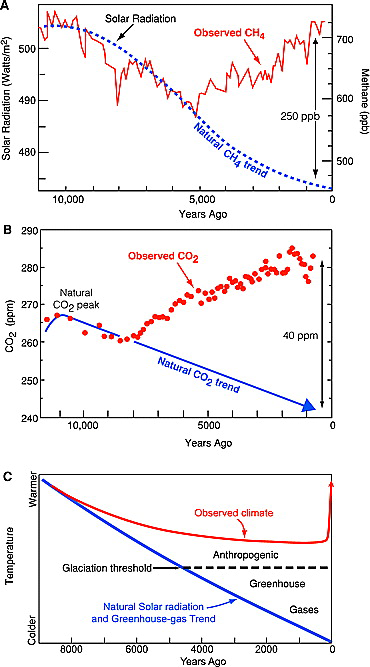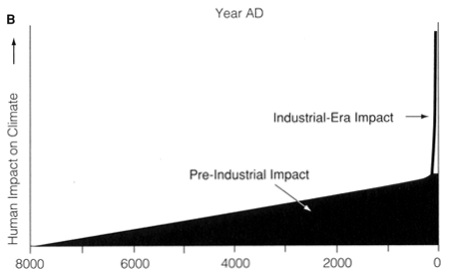The Natural Cooling part:
The orbital (or Milankovitch) changes, which are linked to the switch between glacial and interglacial conditions,
are shown in this graph
(note 'zero' Time, in the 'middle'):

After a peak in heating,
at 11,000 years ago, most of the COOLING from this cycle has bottomed out; and over the coming millennia it will continue cycling around its average.
===
But the temperatures have been relatively level, as shown by the colored line below, instead of cooling and following the ‘orbital cycle curve’ as might be expected. [“The last 8,000 years have not cooled (moderately) as Milankovitch alone would have suggested.” -https://www.cabrillo.edu/]

===
A “warming force,”
which offsets the cooling influence of
the orbital change (
graphed above), can be found by looking at greenhouse gas changes.

===
The Human Influence part:

...
from an article in: New Scientist, 11 December 2003 by Robert Adlerhttp://www.newscientist.com/article/dn4464-early-farmers-warmed-earths-climate.html#.U-jEBfldWSo “During the previous three periods between ice ages,
levels of carbon dioxide and methane in the air fell in lockstep with decreases in summer sunshine caused by cyclical changes in Earth's orbit. But after the most recent ice age, which peaked about 12,000 years ago, the two gases broke the pattern (see graphic [
above]).”
“Our tampering with Earth's climate did not begin just a few decades or centuries ago, but 8000 years before, with the birth of agriculture. This controversial theory drastically widens the debate about the timing and extent of humans' impact on the Earth.”
There could easily be other sources for these greenhouse gases; but whatever their source, their greenhouse-heating effects are well documented.
And those heating effects have offset the cooling ‘orbital’ trend, maintaining a level slope for the resulting ‘global temperature’ curve.
Specifically, that would be 'offsetting' to maintain a 'level slope’
during the “Pre-Industrial” era,
as shown in this graphic for “human impact on climate.”
 The problem of course, is the nearly-vertical line
The problem of course, is the nearly-vertical line of the “Industrial-Era Impact” shown for the recent human influence on climate.
===
We are now drastically over-compensating (in red, below) for the natural global cooling; and enough so to change the ‘level slope’ of climate,
upon which our civilization has depended for millennia.
 http://www.nature.com/scientificamerican/journal/v292/n3/full/scientificamerican0305-46.html
http://www.nature.com/scientificamerican/journal/v292/n3/full/scientificamerican0305-46.htmlScientific American 292, p.46-53 (2005)
Notably, this ‘level slope,’
or the “actual trend” shown above, includes the Roman Warm Period, the Dark Ages,
The Medieval Warm Period, and the Little Ice Age;
but those historical ‘variations’ of average climate are practically unnoticeable at these large scales,
covering
thousands to
hundreds of thousands of years,
which show climate’s usual variability and the huge range of past (
and potential) climate changes.
~





 ...
...


